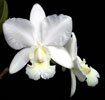|
|
|
|
|
| |
Flasks of
Cattleya walkeriana var. alba 'Pendentive' AM/AOS × self |
|
| |
|
|
| |
| Number: |
TN5908 |
| Name: |
Cattleya walkeriana var. alba 'Pendentive' AM/AOS × self
|
| Type: |
self (What's that?) |
|
Seed Donor: |
Patricia A. Thomas
|
|
Click to Enlarge

Pod Parent Flowers |
|
|
|
| |
Culture Notes from Donor: Parent plant: Temperature range I (60-83°F)
Comments: Parent plant: Arguably one of the best walkeriana cultivars around. Temperature tolerant to a wide range. It lives up to its name by walking out of any pot it inhabits. It likes to be mounted if possible. Flowers are very nicely scented. Small plant.
For additional origin/habitat information supplied courtesy of
Charles and Margaret Baker, see further below, near the bottom of this page.
|
Temperatures we attempt to use in the lab & greenhouse:
| For Infraspecies: |
|
Spring, Summer, Autumn, Winter: days average 79°F, nights 63°F; best fit is Intermediate 83-60°F
(Source:
Baker's Web OSC) |
| For Infraspecies: |
|
Winter: days average 75°F, nights 52°F; best fit is Cool 70-52°F
(Source:
Baker's Web OSC) |
| For Species: |
|
Spring, Summer, Autumn: days average 79°F, nights 63°F; best fit is intermediate 83-60°F
(Source:
Baker's Web OSC) |
| For Species: |
|
Winter: days average 75°F, nights 52°F; best fit is Cool 70-52°F
(Source:
Baker's Web OSC) |
| For Genus: |
|
Spring, Summer, Autumn, Winter: days average 83°F, nights 60°F; best fit is Intermediate 83-60°F
(
) |
|
About the name...
| Etymology of |
alba |
|
From Latin "albus" white.
(Source:
Brown 1956) |
| Etymology of |
Cattleya |
|
Named in honor of William Cattley, English horticulturist in the 19th century.
(Source:
Pridgeon 1992) |
| Etymology of |
walkeriana |
|
Named for Edward Walker, Gardner's assistant, who found the plant.
(Source:
Borders) |
| Pronunciation of |
alba |
|
AL-ba
(Source:
Hawkes 1978) |
| Pronunciation of |
Cattleya |
|
KAT-lee-ya
(Sources:
Pridgeon 1992, Hawkes 1978) |
| Pronunciation of |
walkeriana |
|
wal-ker-ee-AH-na
(Source:
Hawkes 1978) |
|
If you would like to direct someone to this web page, please copy and paste this URL into your email:
http://troymeyers.com/d?015908
| Flask Information |
| Availability: |
We have sold all of the flasks for this item. |
| You should: |
Consider getting individual plants or compots instead of a flask.
See if we have plants available in the greenhouse. |
| Yield Estimate: |
2530 plants (based on flask surveys done 04/22/2008 through 02/02/2015)
|
| Plantlet Sizes: |
From many flasks 10 - 80 mm plants (based on flask surveys done 04/23/2008 through 01/05/2016)
From one most recently surveyed flask 30 - 50 mm (01/05/2016)
|
|
You might also want to:
|
View the seed assay for this item.
See if we have plants available in the greenhouse.
View items of the same species.
View items of the same genus.
|
| Ordering Information |
| You are not currently logged in. |
|
You must be a registered user and be logged in to reserve a flask or place a notification request. Please log in:
|
|
|
|
|
|
| |
The origin/habitat information below is supplied courtesy of Charles and Margaret Baker
The following information is based on the name of the plant provided by the donor, and assumes that the name is correct. If the plant has been misidentified, then the following information may not be correct.
This text is copyrighted by the Bakers and may not be reproduced without permission.
ORIGIN/HABITAT: Brazil. C. walkeriana is found over a large region of the
interior south of the Amazon Basin, including the States of Minas Gerais,
Goias, and Mato Grosso. Brasilia is just west of the center of this area
of distribution, Belo Horizonte is near the southeast edge, and Goiania is
near the western edge. Within this overall area of distribution, plants
are usually found at 2000-3000 ft. (610-910 m), growing in two distinct
types of habitat. In one type, plants are found on very rough barked trees
which grow in an alkaline environment on limestone bluffs, ridges, and
mesas known locally as pedreiros. While the region is very dry much of the
year, the limestone of the pedreiros is able to soak up and retain large
amounts of water during the rainy season. This moisture is given up very
slowly as the surrounding trees respire it into the air through their leaf
surfaces, providing a relatively stable source of high microclimate
humidity in an otherwise dry environment.
The second type environment, known locally as chapada, is in regions where
the limestone was not deposited on the underlying granite. The relatively
flat granite plateau has been cut by eroding streams, leaving almost
perpendicular cliffs as much as 1000 ft. (300 m) tall on either side. C.
walkeriana is found in this habitat where streams plunge over the edge of
the cliffs. They usually grow with their roots attached to bare granite
rocks near the top of the cliffs along with lithophytic cacti, succulents,
and epiphyllums. Some plants are found on rough-barked trees near the edge
of the cliffs, but they are never very far from streams or areas with
permanent water seepages. Moisture rising from the waterfalls condenses as
soon as the temperature starts to drop in the evening and quickly covers
plants and rocks in the vicinity with large amounts of water, even during
the dry season.
More about this information and the Bakers...
|
|
|
| |
|
|
|